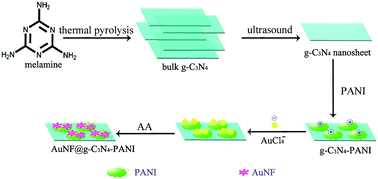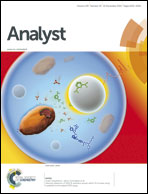Enhanced electrochemiluminescence sensor for detecting dopamine based on gold nanoflower@graphitic carbon nitride polymer nanosheet–polyaniline hybrids
Abstract
In this work, an enhanced electrochemiluminescence (ECL) sensor based on gold nanoflower@graphitic carbon nitride polymer nanosheet–polyaniline hybrids (AuNF@g-C3N4–PANI) was prepared for the detection of dapamine (DA). First, the bulk g-C3N4 was prepared through polymerizing melamine under 600 °C. And then the g-C3N4 nanosheet was obtained by ultrasonication-assisted liquid exfoliation of bulk g-C3N4. Finally, polyaniline (PANI) and gold nanoflowers (AuNFs) were successively formed on the g-C3N4 nanosheet through an in situ synthesis method. The resulting AuNF@g-C3N4–PANI hybrids were modified onto the surface of glassy carbon electrode to achieve a sensor (AuNF@g-C3N4–PANI/GCE) for detecting dopamine. Under the optimal conditions, the ECL signal increased linearly with the concentration of dopamine. The linear range of 5.0 × 10−9 to 1.6 × 10−6 M was obtained, while the detection limit was 1.7 × 10−9 M. The prepared sensor exhibited a low detection limit and high sensitivity for the determination of dopamine. The combination of g-C3N4 nanosheet, PANI and AuNF would provide a new opportunity for the ECL sensor.


 Please wait while we load your content...
Please wait while we load your content...